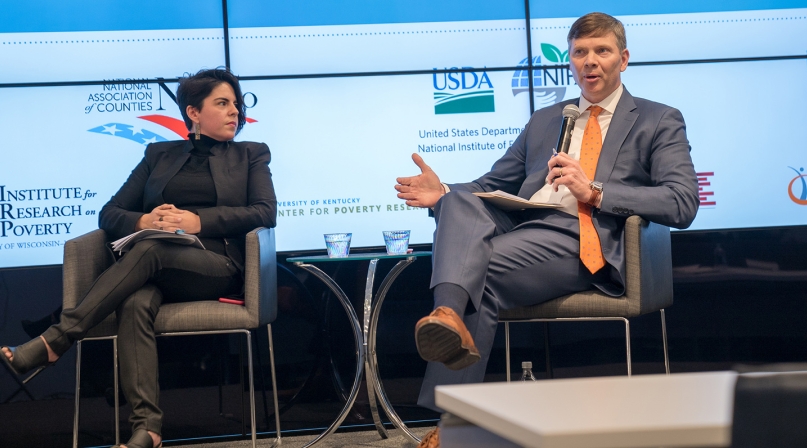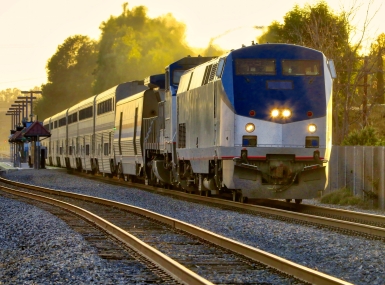America’s counties build infrastructure

County leaders use every tool at our disposal to fund and finance infrastructure projects for our residents, but we need a reliable federal partner to invest in our communities and streamline processes that inhibit our progress
The following op-ed appeared in the Washington Times on March 21.
A few weeks ago, we were honored to host U.S. Transportation Secretary Elaine L. Chao at the National Association of Counties (NACo) Legislative Conference in Washington, D.C. She discussed President Donald Trump’s infrastructure plan with an audience of nearly 2,000 elected and appointed county officials. The room reflected the nation’s diversity — with attendees from Valley County, Idaho (population 10,000) to attendees from Los Angeles County (population 10 million). Across this diverse landscape, counties are eager for a continued conversation about how we build for the future.
Infrastructure has played a vital role in moving the people and goods that keep our country growing — from canals to railroads to our pioneering interstate system. Yet, when we started building the federal interstate system in the 1950s, the U.S. population was only 158 million. We’ve doubled in population to 325 million today, with projections to add another 75 million people by 2050. This population growth, combined with global commerce and trade, has experts predicting an increase in freight movements by more than 40 percent by the year 2040.
To support all this, counties invest more than $122 billion annually in building infrastructure and maintaining and operating public works. We own more than 38 percent of America’s bridges and build and maintain 46 percent of public roads. We are also involved in a third of the nation’s airports and support 78 percent of all public transportation systems. Recognizing our vast role in building the foundations for our economy, we welcome a renewed focus on upgrading our nation’s infrastructure.
Building and maintaining reliable infrastructure necessitates dedicated investments and reliable partnerships. In recent decades, projects have been challenged by federal and state budget uncertainty and ever-growing state and federal mandates on local governments. States also limit the amount of revenue counties can generate. At the same time, construction costs continue to rise above inflation.
In the face of these challenges, county leaders use every tool at our disposal to fund and finance infrastructure projects for our residents. To help move the dialogue forward, NACo recently released a report, “Investing in America’s Infrastructure,” that showcases how counties have implemented novel strategies and financial solutions to deliver much-needed infrastructure. See the report and other examples of counties’ infrastructure leadership at www.NACo.org/CountiesBuild.
The NACo report examines the challenges counties face in changing demographics, relationships with state and federal governments, and funding projects. And just as President Trump’s infrastructure plan calls for innovative financing and community partnerships, the NACo report showcases some best practices for how counties are pursuing these approaches.
For example, Montgomery County, Maryland, partnered with a private developer to replace a community facility that serves the county’s low-income and homeless population — at no cost to taxpayers. The facility, called Progress Place, provides a variety of services, including food, medical services and shelter.
In 2011, Montgomery County issued a call to private developers interested in building a new Progress Place on nearby county-owned property at little-to-no cost to the county. The location of the new building was an underutilized surface parking lot behind a county-owned fire station, which meant new land did not have to be procured. In exchange, the developer would receive the title to the plot where the previous building was located and the opportunity to develop the former site.
The county and private developer collaborated in the design and construction of the new facility, and this partnership resulted in delivering it in record time.
Not all projects proceed so smoothly. Designing, approving and constructing infrastructure can occur along staggering timelines. Five road projects in one Midwest county were delayed for more than two years due to the federal permitting process. And time is money. The county conservatively estimated that the delay costs amounted to half a million dollars.
Stories like this abound when you speak with infrastructure experts, especially those on the ground at the county level. That is why we are particularly pleased to see President Trump’s interest in to streamlining the permitting process and reducing unnecessary regulatory hurdles.
Much is at stake in the national conversation on infrastructure. As leaders at the county level, we want strong local economies for our residents and healthy business environments that can compete. We know how to make it happen. It’s what county leaders have done for decades, in the face of growing constraints. But we recognize that more needs to be done.
To build upon our efforts and to seize this unique opportunity, we need a reliable federal partner to invest in our communities and streamline processes that inhibit our progress. Transformational improvements to America’s infrastructure have always been the result of strong federal-state-local partnerships. We stand ready to work with the administration and Congress — along with other public, private and nonprofit sector allies — to reinvest in our communities.
Attachments
Related News

Counties directly eligible for $5.2 billion in competitive transportation grants
Counties are directly eligible for $5.2 billion in competitive transportation grants.

Counties directly eligible for $2.4 billion through USDOT rail safety improvement program
Counties are directly eligible for $2.4 billion through USDOT rail safety improvement program.

County Countdown – March 19, 2024
Every other week, NACo’s County Countdown reviews top federal policy advocacy items with an eye towards counties and the intergovernmental partnership.
